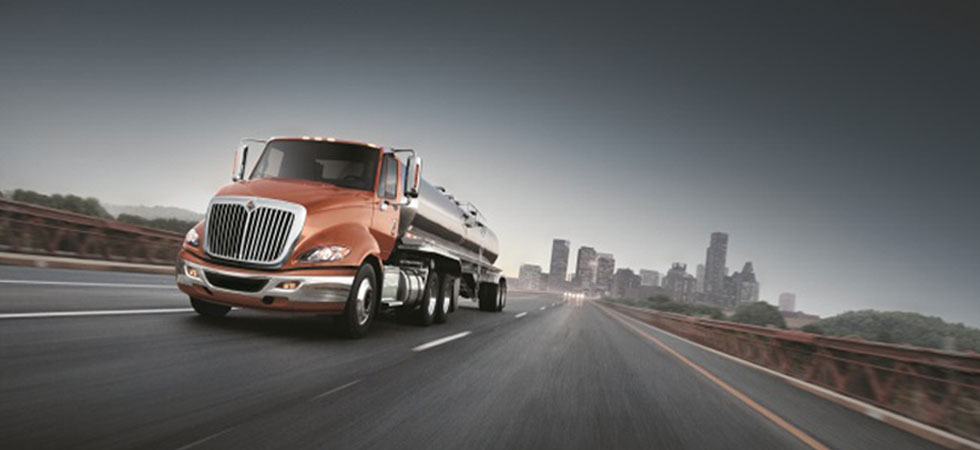Pulling a tanker trailer, especially one without internal baffles is much more challenging than pulling a standard dry van trailer. Those who have pulled a tanker trailer have experienced the sloshing effects. This aspect of hauling liquid loads, such as chemicals, can be very intimidating at first for the driver.
Some tankers have baffles (internal compartment dividers) and some don’t — it depends on what the customer prefers and the nature of the product. Baffles prevent excessive movement of the liquid product in the trailer. In these trailers, the internal movement of the product is minimal.
However, in a tanker without baffles, where there’s just one liquid product, it’s a completely different story. A tanker without baffles handles differently than any other trailer. The braking and handling of the trailer when driving is very different, due to the product’s movement.
If the product gets too much motion when the truck is traveling down the road, the movement of the product can actually take over the direction and control of the truck. Just stopping at a set of lights, a stop sign or just slowing down can be quite an adventure for the driver. Try to imagine dealing with product movement on an icy road or in heavy traffic: It’s not a fun experience.
Chemical and Food Grade
Food grade tankers tend to average 43 feet in length and hold a volume of product about 7,000 gallons on average. There are no internal baffles in these liquid trailers. Customers fear contamination of their load of product by residue of previously hauled products in the trailer, which could get trapped in baffle walls and seams. It is also much easier for a wash crew to guarantee a clean trailer if there are no baffles. Product also unloads more quickly and efficiently without the restriction of baffles.
Finally, trailer washouts between loads are expensive — starting at $200 for a simple hot water flush and ranging up into the thousands of dollars, should the trailer require an acid wash and scraping to remove hardened product. Shippers and receivers don’t wish to bear the even greater costs of a washout for a trailer with baffles.
Enjoying our insights?
Subscribe to our newsletter to keep up with the latest industry trends and developments.
Stay InformedLoading and unloading are often done by the respective shippers and receivers. This is especially the case with hazardous materials (hazmat) loads, including chemicals. When the shippers and receivers are responsible, it helps control the multiple risk factors involved.
Product is usually loaded through an open dome in the roof of the trailer and unloaded through a three-foot nozzle at the bottom rear of the trailer.
Loads can be off loaded by gravity drop. This is done by opening the valve at the rear of the trailer, attached to a hose feeding into an underground storage compartment, pumped off by a liquid pump or ‘aired off’ by pressurizing the trailer and forcing the product out through a hose in the rear of the trailer.
Petroleum hauling includes everything from hauling jet fuel for airlines to delivering gasoline and diesel fuel to gas stations and truck stops. The fuel is loaded in refineries. Due to the vast number of refineries across the country, this work usually involves short hauls.
Petroleum products are usually loaded and unloaded by the truck driver. For the most part, trucking companies tend to utilize company trucks and company drivers, as opposed to owner operators.
Compartment tanker trailers are used for petroleum products, often in the form of B trains, depending on the region. The sloshing movement factor is greatly reduced in compartment trailers with baffles, as the baffles control the excessive movement of the liquid product.
Hauling and handling petroleum products is still more dangerous than hauling general freight products, as these products are highly flammable. Drivers who are smokers should consider a different type of trucking.
Because of the constant demand by our society for fuel, petroleum tanker companies always seem to have lots of work. These driving jobs generate steady, reliable income for drivers.
One should be aware though, because of the constant demand for fuel, the work goes on 24 hours per day, often requiring drivers to work night and weekend shifts. Slip seating is also common in the petroleum hauling business, to keep the trucks moving with this high demand product.
Dry Bulk
Dry bulk tanker trailers haul anything from sugar and cement to plastic pellets. The freight is not hazardous or dangerous in any way.
These trailers are offloading by pressurizing their products, usually by a large drum compressor which attaches to the tractor unit. There is no slosh factor at all associated with these types of tankers, so many tanker drivers prefer this type of work. Dry bulk trailers tend to be large, high and long as the products are lighter. Generally customers like to move as much product in one load as possible. Hauling dry bulk in tanker trailers tends to be short haul work. Long-haul dry bulk is normally done by rail.



















